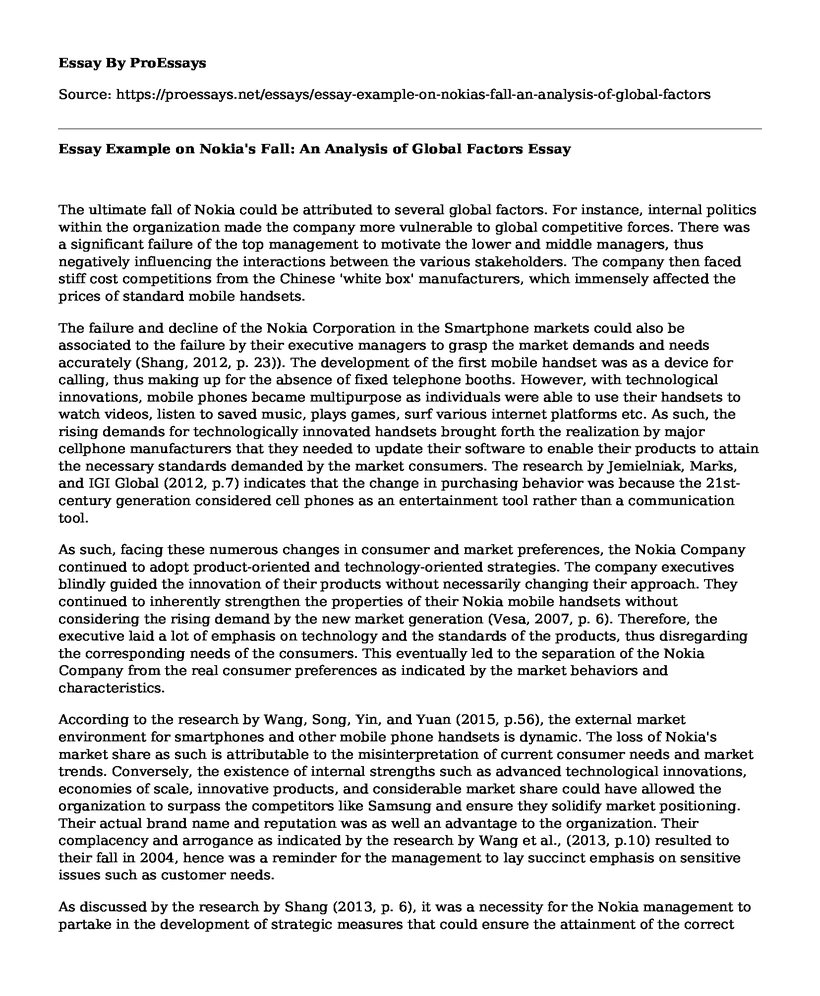The ultimate fall of Nokia could be attributed to several global factors. For instance, internal politics within the organization made the company more vulnerable to global competitive forces. There was a significant failure of the top management to motivate the lower and middle managers, thus negatively influencing the interactions between the various stakeholders. The company then faced stiff cost competitions from the Chinese 'white box' manufacturers, which immensely affected the prices of standard mobile handsets.
The failure and decline of the Nokia Corporation in the Smartphone markets could also be associated to the failure by their executive managers to grasp the market demands and needs accurately (Shang, 2012, p. 23)). The development of the first mobile handset was as a device for calling, thus making up for the absence of fixed telephone booths. However, with technological innovations, mobile phones became multipurpose as individuals were able to use their handsets to watch videos, listen to saved music, plays games, surf various internet platforms etc. As such, the rising demands for technologically innovated handsets brought forth the realization by major cellphone manufacturers that they needed to update their software to enable their products to attain the necessary standards demanded by the market consumers. The research by Jemielniak, Marks, and IGI Global (2012, p.7) indicates that the change in purchasing behavior was because the 21st-century generation considered cell phones as an entertainment tool rather than a communication tool.
As such, facing these numerous changes in consumer and market preferences, the Nokia Company continued to adopt product-oriented and technology-oriented strategies. The company executives blindly guided the innovation of their products without necessarily changing their approach. They continued to inherently strengthen the properties of their Nokia mobile handsets without considering the rising demand by the new market generation (Vesa, 2007, p. 6). Therefore, the executive laid a lot of emphasis on technology and the standards of the products, thus disregarding the corresponding needs of the consumers. This eventually led to the separation of the Nokia Company from the real consumer preferences as indicated by the market behaviors and characteristics.
According to the research by Wang, Song, Yin, and Yuan (2015, p.56), the external market environment for smartphones and other mobile phone handsets is dynamic. The loss of Nokia's market share as such is attributable to the misinterpretation of current consumer needs and market trends. Conversely, the existence of internal strengths such as advanced technological innovations, economies of scale, innovative products, and considerable market share could have allowed the organization to surpass the competitors like Samsung and ensure they solidify market positioning. Their actual brand name and reputation was as well an advantage to the organization. Their complacency and arrogance as indicated by the research by Wang et al., (2013, p.10) resulted to their fall in 2004, hence was a reminder for the management to lay succinct emphasis on sensitive issues such as customer needs.
As discussed by the research by Shang (2013, p. 6), it was a necessity for the Nokia management to partake in the development of strategic measures that could ensure the attainment of the correct customer needs evaluation and grasp. In this case, the consideration of the developing consumer needs, behavior, and characteristics would have brought forth a brief assessment of the market preferences. This failure by the management as exemplified by Lei, Chatwin, and Young et al. (2004, p.13) was the critical aspect that resulted to the market share miss-out by Nokia concerning the sales of the emerging smartphone technologies. The inflexibility of the Nokia Company as indicated by Shang (2012, p. 3) was as well a contributing factor that brought forth the emergence of barriers that hindered their progressive integration into the Smartphones market. The company, as indicated through the research studies, was over pursuing on issues concerning cost control, thus leading to operational failure and decline.
References
Jemielniak, D. ed., 2012. Managing Dynamic Technology-Oriented Businesses: High-Tech Organizations and Workplaces: High-Tech Organizations and Workplaces. IGI global.
Kerin, R.A., 2009. Marketing, 9. izdanje.
Lei, P.W., Chatwin, C.R., Young, R.C.D. and Tong, S.H., 2004. Opportunities and limitations in M-commerce. In Wireless communications and mobile commerce (pp. 80-104). IGI Global.
Shang, T.M., 2012. To Live or To Die, It's a Question for Nokia. State-Owned Enterprise, 10.
Vesa, J., 2005. Mobile Services in a Networked Economy. In Mobile Services in the Networked Economy (pp. 212-218). IGI Global.
Wang, D., Song, X., Yin, W. and Yuan, J., 2015. Forecasting core business transformation risk using the optimal rough set and the neural network - Journal of Forecasting, 34(6), pp.478-491.
Cite this page
Essay Example on Nokia's Fall: An Analysis of Global Factors. (2023, Feb 27). Retrieved from https://proessays.net/essays/essay-example-on-nokias-fall-an-analysis-of-global-factors
If you are the original author of this essay and no longer wish to have it published on the ProEssays website, please click below to request its removal:
- Collaboration Software Tools
- Communication Mechanisms That Can Be Adopted by Dean and Top Management
- Good Communication in the Organization
- Paper Example on Smash Burger: Corporate Strategies Recommendations
- The Significance of Using Risk Communications as a Public Health Leader - Paper Example
- Essay Sample on Differences Between the ADB, WB and IMF
- Paper Example on XYZ Inc. to Raise Money: Bonds vs. Stocks







